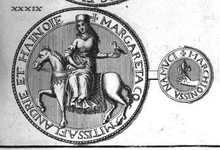Margaret I, Countess of Flanders
Margaret I (c. 1145 - died 15 November 1194) was the countess of Flanders suo jure from 1191 to her death.
Margaret I | |
|---|---|
 Margaret's effigy on a seal | |
| Born | circa 1145 |
| Died | 15 November 1194 |
| Buried | St. Donatian's Cathedral in Bruges |
| Noble family | Metz |
| Spouse(s) | Ralph II, Count of Vermandois Baldwin V, Count of Hainaut |
| Father | Thierry, Count of Flanders |
| Mother | Sibylla of Anjou |
Early life
Margaret was the daughter of Count Thierry of Flanders and Sibylla of Anjou.[1] In 1160 she married Count Ralph II of Vermandois.[2] Due to his leprosy, the marriage could not be consummated and remained childless. He died of leprosy in 1167 without issue. In 1169 she married Count Baldwin V of Hainaut,[1] a scion of the House of Flanders.
Countship
In 1191, Margaret's brother Count Philip I of Flanders died childless, and she as his heir claimed the county of Flanders with the support of her husband. Her claims was questioned by the king of France who, with support of Ghent, declared Flanders escheated to the crown due to the lack of male heirs, a problem that was not solved until the Treaty of Arras by the mediation of the archbishop of Riems.[3] They met some unrest among the nobility of the area, foremost by her brother's widow, Theresa of Portugal, who was given extensive dower lands in the coastal and southern Flanders where she provoked considerable unrest by high taxation.[3]
The right of Margaret and her husband to the County of Flanders was not finally acknowledged until 1 March 1192.[3] As countess, she objected to all foreign legal independence in her lands, and accordingly, she prevented the Hanse merchants living in Bruges from acquiring a separate quarter and rights for themselves in the port of Damme. [4]
Margaret died on 15 November 1194; as her husband had become count of Flanders only by marriage, he could not remain sole count, and Margaret was succeeded by their son Baldwin IX.[5]
Issue
- Isabella, married Philip II of France[1]
- Baldwin IX of Flanders (1171–1205),[1] also count of Flanders and Latin Emperor
- Yolanda (1175–1219), married Peter of Courtenay, Latin Emperor
- Philip I of Namur (1175–1212)
- Henry of Flanders (1176–1216), Latin emperor of Constantinople
- Sybille (1179–9 January 1217), married c. 1197 Guichard IV, Sire de Beaujeu. They had a daughter, Agnes of Beaujeu.
- Eustace (d. 1219), regent of the Kingdom of Thessalonica
- Godfrey
References
- Evergates 1999, p. 114.
- Evergates 1999, p. 126.
- Nicholas 1992, p. 74.
- Classen, Albrecht (ed.) Handbook of Medieval Culture, Volym 2, 2015
- Nicholas 1992, p. 75.
Sources
- Evergates, Theodore, ed. (1999). Aristocratic Women in Medieval France. University of Pennsylvania Press.CS1 maint: ref=harv (link)
- Nicholas, David (1992). Medieval Flanders. Longman.CS1 maint: ref=harv (link)
| Wikimedia Commons has media related to Margaret I of Flanders. |
| Preceded by Philip |
Countess of Flanders 1191–1194 with Baldwin VIII (1191–1194) |
Succeeded by Baldwin IX |